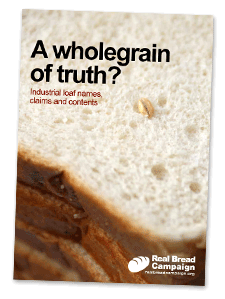Sustain / Real Bread Campaign / About / Marketing and labelling
Wholegrain
 Wholegrain
Wholegrain
Real Bread made with whole grain ingredients is great!
But just how far can you trust industrial loaf marketing that crowns products with the healthy halo of wholegrain?
- What is wholegrain?
- Is wholegrain the same as wholemeal?
- So what guarantee does the word wholegrain give me?
- How do I know the amount of wholegrain ingredients a product has?
- What has the Real Bread Campaign got against wholegrain?
- What if I think the word wholegrain is being misused?
- Where can I learn more?
What is wholegrain?
As the UK Whole Grain Guidance Note (see below) admits, 'there is no agreed UK definition for whole grain.' It goes on to say that 'the term generally refers to the entire edible grain (including the germ, endosperm and bran) from cereals and related plants.'
Is wholegrain the same as wholemeal?
No.
Though given the similarity between the words, you'd be forgiven for asking.
The word wholemeal is (in theory) protected by law.
The Bread and Flour Regulations 1998 demand that:
1) There shall not be used in the labelling or advertising of bread, as part of the name of the bread, whether or not qualified by other words -
(a) the word ‘wholemeal’ unless all the flour used as an ingredient in the preparation of the bread is wholemeal;
(2) No person shall sell or advertise for sale any bread in contravention of this regulation.
The Food Standards Agency’s guidance notes on the Regulations point out: ‘The term “wholemeal” is not defined in law, however it is generally accepted that wholemeal flour is the entire wheat grain, which contains the bran and the germ.’
Quite how well this is working is something we question in our A Wholegrain of Truth? report.
The word wholegrain is afforded no such protection.
So what guarantee does the word wholegrain give me?
Good question!
FDA regulations demand that for the term wholegrain to be used in the USA, the product must contain 51% unrefined grain ingredients.
And the UK?
Well, there is no legal minimum requirement and so, as we note in our A Wholegrain of Truth? report, manufacturers can (and do) use the term to market products that have startlingly small amounts - in one case as low as 6% of the declared ingredients.
In lieu of the government setting mandatory standards, or even issuing guidance, all we appear to have is the - non-binding - UK Whole Grain Guidance Note, issued in 2007 by the Institute of Grocery Distribution. The majority of members of the working group that produced the report are representatives of industrial food businesses. It suggests that 'for packaged foods wishing to communicate the presence of whole grain, for example, by stating ‘contains whole grains’ or ‘with whole grains’ on pack and in brand communications, the IGD Working Group recommend that foods should contain a minimum level of 8g whole grain per serving.'
We don't believe that this voluntary arrangement is adequate. In order for shoppers in the UK to know where they stand and be in a position to make a fully-informed choice, the word wholegrain needs legal protection.
How do I know the amount of wholegrain ingredients a product has?
As the UK Whole Grain Guidance Note points out: 'In line with EU labelling legislation 2, highlighting the inclusion of whole grain on a food package (e.g. by stating ‘with whole grain’ or ‘made with whole grains’) will automatically trigger the requirement to provide a Quantitative Ingredient Declaration (QUID). This provides a mechanism for consumers and other interested parties to assess the level of whole grain present.'
In short - if a loaf is marketed using the term wholegrain, the ingredients list should state them and their percentage by weight.
What has the Real Bread Campaign got against wholegrain?
Nothing!
We strongly support people eating more Real Bread with higher levels of unrefined flour or other wholegrain ingredients.
What we do have an issue with is the lack of protection the word has, leaving shoppers vulnerable to being misled by manufacturers and retailers using the healthy halo of wholegrain to market products that have. As part of our call for an Honest Crust Act, we demand that wholegrain should be given a meaningful legal definition that is properly policed.
The Real Bread Campaign does not:
- Dispute the value of eating 100% wholemeal Real Bread.
- Aim to dissuade bakers from including more nutritious, higher-fibre unrefined grain (i.e. wholegrain) ingredients in other loaves, or discourage people from eating them.
What if I think the word wholegrain is being misused?
As with anything you see that you believe to be misleading, first raise the issue with the manufacturer and/or retailer. If you don't find their response adequate or satisfactory, follow the procedures of the relevant authority.
- For product labelling or point of sale marketing, contact the trading standards department of your local authority
- For advertisements, contact the Advertising Standards Authority
...and then please let us know how you got on!
Where can I learn more?
We cover this subject in more details in our A Wholegrain of Truth? report.
Real Bread Campaign: The Real Bread Campaign finds and shares ways to make bread better for us, better for our communities and better for the planet. Whether your interest is local food, community-focussed small enterprises, honest labelling, therapeutic baking, or simply tasty toast, everyone is invited to become a Campaign supporter.


